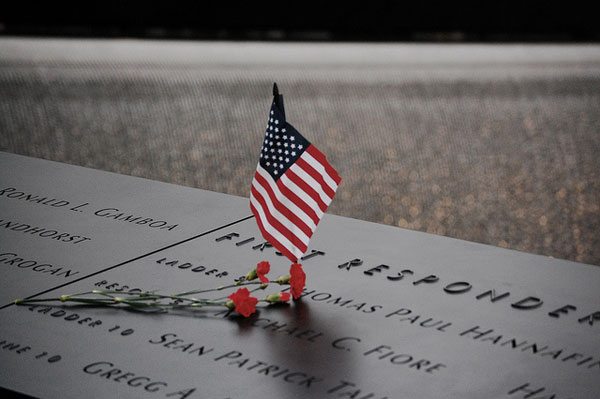
September 10, 2017; Los Angeles Times
There are some people around us who run towards disasters, putting themselves in danger to help those who are hurt. They represent the selfless soul of service to others—of civil society—but in the case of the attacks on September 11, 2001, where first responders—police officers, firefighters, construction workers and volunteers—worked in thick toxic clouds, the wages of that selflessness are great and long-lasting.
Raymond and Robert Alexander died within months of each other this past year from 9/11-related illnesses, said Gerard Fitzgerald, president of the Uniformed Firefighters Association. Father and son, both firemen were first responders to 9/11, and both died of cancers tied to the ash, debris, and carcinogens at the scene.
“We had firefighters show symptoms very early after 9/11 in age groups that they shouldn’t have been showing symptoms for different diseases, specifically cancer,” Fitzgerald said. “The impact of 9/11 is not over, and it doesn’t seem like it’s going to be over for a long, long time. I can’t imagine how the Alexander family feels, but I would hope that the entire country will keep them in their prayers and remember what happened on that terrible day and what continues to go on here in New York.”
Today, a dedication ceremony will be held for a memorial on a Long Island beach where people watched in horror as the World Trade Center towers collapsed. The memorial honors those who died not only from the attack itself but from a range of ailments acquired in trying to help in the aftermath or simply living in the area; in the end, these latter victims may outnumber the original ones.
Researchers estimate that the choking dust that coated the Ground Zero recovery site—and persisted in the air for days afterward—contained a hazardous mix of airborne particles, including aluminum, asbestos, glass and the remnants of burned jet fuel…Scientists studying exposure to those airborne hazards have linked them to lung disease, asthma and cancer, and the federal government has taken steps in recent years to help tackle these lasting health challenges.
The monument comprises a twisted, 30-foot beam of Trade Center steel, an elevated walkway, and granite plaques with the names of the original 3,000 victims. Another plaque will hold 528 additional names of first responders who died from exposure to the environment during the rescue and cleanup.
This latter plaque leaves plenty of room for additional names. The number of responders who worked at Ground Zero in New York is reckoned at between 60,000 and 70,000. The numbers of those responding to the attack sites at the Pentagon and in Pennsylvania are less clear, and the estimated number of additional responders who may remain to be contacted ranges from 10,000 to 30,000.
Sign up for our free newsletters
Subscribe to NPQ's newsletters to have our top stories delivered directly to your inbox.
By signing up, you agree to our privacy policy and terms of use, and to receive messages from NPQ and our partners.
In June [2017], the World Trade Center Health Program, the federally funded organization that helps provide medical treatment for people affected by the attacks, counted more than 67,000 responders and 12,000 attack survivors as enrollees. The program receives hundreds of new participants each month, including nearly 400 new enrollees in June alone. Since the program began in 2011, more than 1,300 members have died, although not all deaths could be directly attributed to Sept. 11-related illnesses.
The federal Victim Compensation Fund provides financial help for victims’ families, first responders, and survivors of the attacks. Originally scheduled to run from 2001 to 2004, it was reactivated in 2011 through President Obama’s dedicated advocacy, albeit with a great deal of conservative opposition. The fund is now scheduled to operate until 2020.
“I think what the town of Hempstead is doing is nothing short of honorable,” said John Feal, a longtime advocate for responders with illnesses related to their exposure on and after 9/11. “People who lost a loved one to illness suffer just like someone lost on that day. Hopefully this will offer some ease and comfort to them.”
The Hempstead memorial is not the first to honor responders, according to the Morning Call of Pennsylvania.
In May, officials at the National September 11 Memorial & Museum announced plans to set aside a commemorative space at the World Trade Center to honor rescue and recovery workers.
New York’s police and fire departments also have memorials for personnel who have died of illnesses since Sept. 11. A 9/11 memorial in Staten Island recently added a plaque with the names of residents there who have died of illnesses.
Feal’s charitable organization also maintains a memorial wall to 9/11 responders in Nesconset, New York.
“I truly believe that everyone there that day was a hero,” said Robert Gies, who was 13 when his father, a NYC fireman died in the South Tower. “Whether they died on 9/11 or four years later, every person is a hero. Those people who worked there in the aftermath in those hazardous conditions, those people touch my heart. They rushed there to save and find my father. They found him and he was able to be laid to rest. That’s huge closure.”—Ruth McCambridge













